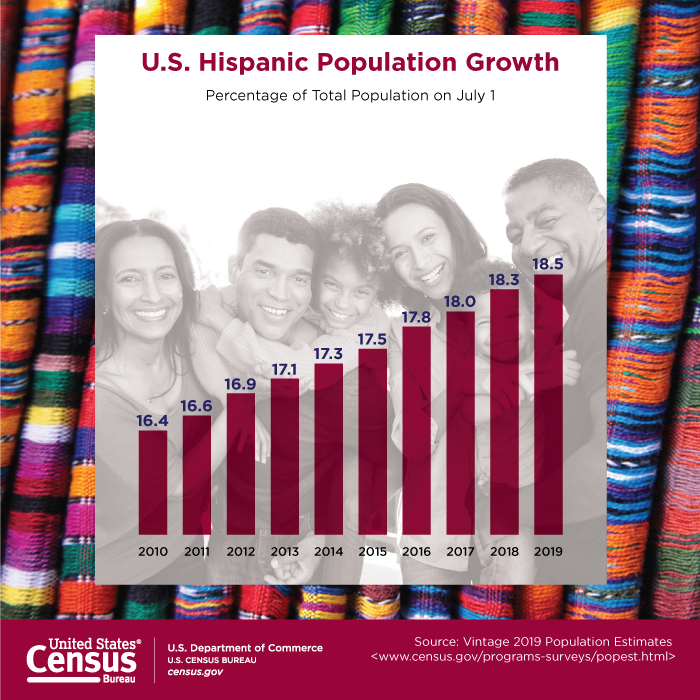
An official website of the United States government
Here’s how you know
Official websites use .gov
A .gov website belongs to an official government organization in the United States.
Secure .gov websites use HTTPS
A lock (
) or https:// means you’ve safely connected to the .gov website. Share sensitive information only on official, secure websites.
- Español / Spanish
-
//
- Census.gov /
- Newsroom /
- Facts for Features /
- Hispanic Heritage Month 2020
Hispanic Heritage Month 2020
Hispanic Heritage Month recognizes and celebrates the contributions Americans tracing their roots to Spain, Mexico, Central America, South American and the Spanish-speaking nations of the Caribbean have made to American society and culture. The observance was born in 1968 when Congress authorized the president to issue an annual proclamation designating National Hispanic Heritage Week. Just two decades later, lawmakers expanded it to a monthlong celebration, stretching from September 15 to October 15.
The timing is key. Hispanic Heritage Month — like its shorter precursor — always starts on September 15, a historically significant day that marks the anniversary of independence of five Latin American countries: Costa Rica, El Salvador, Guatemala, Honduras and Nicaragua. The designated period is also a nod to those from Mexico and Chile, which celebrate their independence on Sept. 16 and Sept. 18, respectively.
The following facts are available thanks to the public’s invaluable participation in U.S. Census Bureau surveys. We appreciate the information shared by each respondent as we continuously count and measure America’s people, places and economy.
Did You Know?
60.6 million
The Hispanic population of the United States as of July 1, 2019, making people of Hispanic origin the nation’s largest ethnic or racial minority. Hispanics constituted 18.5% of the nation’s total population.
Source:
12
The number of states with a population of 1 million or more Hispanic residents in 2019 — Arizona, California, Colorado, Florida, Georgia, Illinois, New Jersey, New Mexico, New York, North Carolina, Pennsylvania and Texas.
Source:
34,358
The increase from 2018 to 2019 in the number of Hispanics in Maricopa, Arizona, the biggest jump in this population during this period.
Source:
Source:
More Stats
See a detailed profile of the Hispanic population from the 2019 American Community Survey. Statistics include:
- Families
- Housing
- Languages
- Education
- Jobs
- Income and Poverty
- Health Insurance
The following is a list of observances typically covered by the Census Bureau’s Facts for Features series:
| Black (African American) History Month (February) Women's History Month (March) Irish-American Heritage Month (March) Asian/Pacific American Heritage Month (May) The Fourth of July (July 4) Anniversary of Americans With Disabilities Act (July 26) Hispanic Heritage Month (Sept. 15-Oct. 15) Halloween (Oct. 31) American Indian/Alaska Native Heritage Month (November) Veterans Day (Nov. 11) Thanksgiving Day/Holiday Season (November-December) |
Editor’s note: The preceding data were collected from a variety of sources and may be subject to sampling variability and other sources of error. Facts for Features are customarily released about two months before an observance in order to accommodate magazine production timelines. Questions or comments should be directed to the Census Bureau’s Public Information Office: telephone: 301-763-3030; or e-mail: pio@census.gov.
Profile America's Facts for Features provides statistics related to observances and holidays not covered by Stats for Stories. For observances not listed below, visit our Stats for Stories web page.
Profile America's Stats for Stories provides links to timely story ideas highlighting the Census Bureau's newsworthy statistics that relate to current events, observances, holidays, and anniversaries. The story ideas are intended to assist the media in story mining and producing content for their respective audiences.
Share
Some content on this site is available in several different electronic formats. Some of the files may require a plug-in or additional software to view.
 Yes
Yes
 No
NoComments or suggestions?


Top




